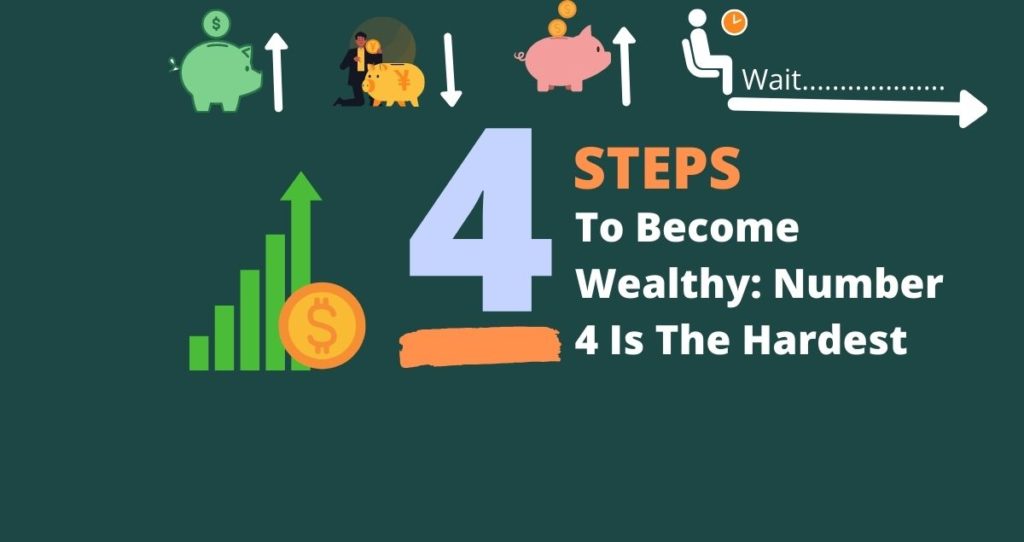Have you been losing money due to picking bad investments or never invested due to the fear of losing your hard-earned money? This is a major problem for millions of people around the country and I faced it myself when I started investing. Investing is one of the best and fastest ways to build wealth. But it is also the fastest way to lose money if you do not follow the right investing strategies. As an investor, one of the best investment strategies you must follow is to understand different types of portfolios and know which portfolio is right for you based on your risk tolerance and desired return on investment(ROI).
With so many types of portfolios to choose from, however, it can be difficult to know which portfolio is right for you or why you should choose a specific portfolio. In this article, I will go over different types of portfolios and help you pick the right portfolio to maximize your ROI.
What is a portfolio?
In simple terms, a portfolio is a collection of different investments an investor chooses to invest hold. Think of a portfolio as a shopping cart. When you go to the market, you put different items in your cart such as clothes, food, drinks, electronics, etc. These same items are also the ones you end up buying.
A portfolio also acts the same way. The only difference is that for a portfolio, you pick investments instead of goods. Items in your shopping car represent to investment in your portfolio while the shopping cart and its goods represent the portfolio.
When you invest money, any investment you pick becomes part of your portfolio. The type of portfolio you create depends on the investments you pick which are determined by your risk tolerance. Just like shopping at a store, different customers have similar carts but the items inside each shopping cart are different.
Portofios also behaves the same way. Just like each person can have a portfolio, my portfolio will be different from yours due to picking different investments. For example, my portfolio can have bonds, real estate, and deposit accounts while yours can have stocks, cryptocurrencies, and stock-based funds.
You might also like: How to invest without losing money: Investing guide for newbies
Key terms I am using in this post
Before we discuss portfolio types, I am going to define a few key terms I will be using in this post.
- Portfolio. A portfolio is a collection of different investments an investor buys
- Fixed income assets. These are asset classes and securities that pay a fixed return usually in dividends and interests. These assets can be made of bonds, deposit accounts, and other fixed-interest investments such as rental properties.
- Equities. The term equity represents the ownership of a company’s shares. For example, if you buy a stock, your equity in the company will be the value of the shares you own. Equities are usually stocks, stock-based funds, etc.
- Return on investment(ROI). Return on investment represents the total return you get from an investment. For example, if you buy a stock for $10 and sell it for $25, your return on investment will be $15.
- Risk tolerance. The risk tolerance represents the level of risk you are willing to take as an investor.
- Asset. An asset is anything you own that has a monetary value
Related post: 53 Personal Finance Terms You Need to Know
What determines the type of portfolios people create?
Typically, the type of investments you add to your portfolio is usually dictated by your risk tolerance, investment timeline, and desired return on investment. For example, risk-averse investors create portfolios that have more fixed-income assets such as bonds than equities.
On the other hand, risk-seeking investors create portfolios that have more equities than fixed income.
Here are different types of portfolios and investing strategies to build a portfolio that maximizes your ROI.
5 different types of portfolios
1. Income portfolio
An income portfolio is a portfolio made of 80% fixed-income assets and 20% equities. To form an income portfolio, focus on buying assets that pay a fixed income or predictable returns until you have reached 80% of your portfolio, then put the rest of your money in equities. An income portfolio is made of income from different assets such as dividends, interest from deposit accounts such as CDs, high-yield savings accounts, bonds, T-bills, and capital gains. The 20% in equities comes from investments such as stocks(large cap stocks) and stock-based funds.
How to form an income portfolio?
To create an income portfolio, use the following strategy.
- 80% fixed income. Fixed income assets include deposit accounts(high-yield savings accounts, CDs, money market accounts), dividend stocks, T-bills, bonds(government bonds, municipal bonds, corporate bonds), annuities, loyalty, etc.
- 20% equities. These assets can be convertible bonds, stocks, stock funds(mutual funds, ETFs, index funds), REITs, commodities, etc.
Who should form an income portfolio?
The income portfolio is the best investment strategy for newbies because the risk is minimal compared to other types of portfolios. With an income portfolio, 80% of your investments are made of fixed-income assets and 20% equities. This investment strategy protects your portfolio from high volatility related to the stock market and similar assets. The downside of an income portfolio is that your return on investment will be lower due to getting lower fixed rates on investments in your portfolio.
For example, the average annual percentage yield(APY) on a 12-month CD is 1.85%, according to the Federal Deposit Insurance Corporation(FDIC). This means that no matter how bad or good the economy is, your return will not change until your CD matures. Fixed rates prevent you from taking advantage of higher rates when rates are rising or reaping higher returns from other investments.
With an income portfolio, you give up higher returns in exchange for safety.
An income portfolio is also good for people who are close to retirement. The closer you get to retirement, the lesser the risk you can afford to take. An income portfolio could also be your best portfolio if you are planning to use your returns as a source of income.
2. Conservative/defensive portfolio
A conservative portfolio is a portfolio made of 60% fixed income and 40% equities. With a conservative portfolio, you are getting access to more returns due increased percentage of equities(from 20% to 40%). However, the risk is still relatively low because you own more fixed income than equities.
How to form a conservative portfolio?
If you want to get more ROI without taking on too much risk, a conservative portfolio will be your next best option.
To create a defensive portfolio, use the following strategy.
- 60% fixed income. Deposit accounts(high-yield savings accounts, CDs, money market accounts), dividend stocks(large cap stocks), bonds, T-bills, bonds(government bonds, municipal bonds, corporate bonds), annuities, and loyalty.
- 40% equities. Convertible bonds, stocks(large cap stocks), REITs, stock funds(mutual funds, ETFs, index funds), commodities.
Who should form a conservative portfolio?
A conservative portfolio is good for someone who wants to minimize risk while keeping ROI relatively modest. Due to having a little more equities in your portfolio, your portfolio’s volatility will go a bit higher. But, your return on investment will also increase increase. That is you take on a little more risk in exchange for a higher return.
Similarly to an income portfolio, your ROI is still lower compared to other types of portfolios we will cover in the next few sections. This is because the more percentage of fixed income you keep in your portfolio, the lower your return will be.
3. Moderate portfolio
A moderate portfolio is a portfolio that is made of 60% equity and 40% fixed income. With this type of portfolio, you experience a little higher volatility compared to a conservative portfolio in exchange for a higher return. A moderate portfolio is good for you if you cannot tolerate too much volatility associated with growth portfolios while still getting a much higher return on investment.
How to form a moderate portfolio?
To form a moderate portfolio, make sure the equities you buy are not more than 60% of your entire portfolio. This way you avoid Taking on too much risk while taking advantage of higher returns associated with equities.
To form a moderate portfolio, use the following strategy.
- 40% fixed income
- 60% equities
Is a growth portfolio right for you?
Since a growth portfolio experiences higher volatility than a conservative portfolio, it will be good for you if you want access to long-term growth while keeping your risk minimal. Yes, 60% of equity is higher but not as high as a growth portfolio.
4. Growth Portfolio
A growth portfolio is a type of portfolio that focuses on the growth of your net worth. Hence, the name growth portfolio. A growth portfolio is made of 80% equities and 20% fixed-income assets. With a growth portfolio, you enjoy high growth of your investments which are mainly stocks and stock-based funds such as mutual funds, ETFs, and Index Funds.
Having a high percentage of equities in your portfolio also means that you experience a high volatility compared to the other types of portfolios I covered earlier. That is your portfolio will directly be affected by economic conditions due to having more stocks than fixed-income assets. For example, during a bear market, your portfolio declines much lower than an income-based or conservative portfolio as stocks experience higher volatility.
How to form a growth portfolio?
A growth portfolio focuses more on assets that increase in value over time and can potentially give you a higher return on investment. This portfolio is right for you if you are looking for long-term growth and can tolerate market volatility. To minimize your risk, you would need to diversify your portfolio with fixed-income assets such as bonds and high-yield deposit accounts.
To create a growth portfolio, use the following strategy.
- 80% equities: Stocks(large cap stocks), convertible bonds, REITs, stock funds(mutual funds, ETFs, index funds), REITs, commodities.
- 20% fixed income assets: Deposit accounts(high-yield savings accounts, CDs, money market accounts), bonds(government bonds, municipal bonds, corporate bonds), annuities, dividend stocks(large cap stocks), bonds, T-bills, and loyalty.
Who should open a growth portfolio?
A growth portfolio is good for anyone who is looking for long-term growth and can tolerate volatility. You should also have some experience in investing which helps you pick the right investments. Experience will also help you cope with prolonged bear markets and prevent you from selling prematurely due to fear of losing your money.
The perfect candidate for a growth portfolio is young people who can afford to take on extra risks for maximum return on investment. For example, if you are in your 20s or 30s, this type of portfolio will be perfect for you as you still have more years to work. Even if some of your investments go south, you can still recover since you still have more time ahead of you. The younger you are, the more risk you can afford to take.
5. Aggressive portfolio
An aggressive portfolio is a portfolio made entirely of equities. With this type of portfolio, your portfolio experiences the highest volatility and it responds to all market directions. The risk is also the highest since most assets can increase in value or lose value over time. That is some of your assets can easily go to zero which will mean a loss of your capital.
For example, some of your stocks could easily lose more than 90% of their values and might not even recover. Unless you have balanced your investments and put protective measures in place, you can easily lose money with this type of portfolio. If you are new to investing, you should not try an aggressive portfolio and it carries more risks and requires strategic planning and active management of your portfolio.
How to form an aggressive portfolio?
Before you put all your money in one basket, try other types of portfolios and learn as much as possible. What makes an aggressive portfolio riskier especially when you are new to investing is that you are putting all your eggs in one basket but your experience and investing skills are limited. For this reason, you are more likely to lose money with an aggressive portfolio than any other type of portfolio.
To form an aggressive portfolio, use the following strategies.
- 100% Equities: Stocks(large cap stocks), commodities, convertible bonds, REITs, stock funds(mutual funds, ETFs, index funds), REITs, currencies.
- 0% Fixed income assets
Who should form an aggressive portfolio?
An aggressive portfolio is made of 100% equities and does not include fixed-income assets which is similar to putting all your eggs in one basket. Due to the risk involved with an aggressive portfolio, only investors with extensive market experience should try this type of portfolio.
An aggressive portfolio will be good for you only if you can tolerate high volatility and expect high returns for the long term. Additionally, this type of portfolio should be considered for the money you are willing to lose.








